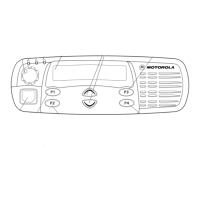Section 3: 1-10 Controller Board Audio and Signaling Circuits
Section : 6881091C63-F
1.15 Static Random Access Memory (SRAM)
The SRAM (U0121) contains temporary radio calculations or parameters that can change very
frequently, and which are generated and stored by the software during its normal operation. The
information is lost when the radio is turned off.
The device allows an unlimited number of write cycles. SRAM accesses are indicated by the CS
signal U0122-20 (which comes from U0101-CSGP2) going low. U0122 is commonly referred to as
the external RAM as opposed to the internal RAM which is the 3 KBytes of RAM which is part of the
68HC11FL0. Both RAM spaces serve the purpose. However, the internal RAM is used for the
calculated values which are accessed most often.
Capacitor C0122 serves to filter out any AC noise which may ride on 5V at U0122.
2.0 Controller Board Audio and Signaling Circuits
2.1 Audio Signaling Filter IC with Compander (ASFIC CMP)
The ASFIC CMP (U0221) used in the controller has 4 functions:
1. RX/TX audio shaping, i.e. filtering, amplification, attenuation
2. RX/TX signaling, PL/DPL/HST/MDC
3. Squelch detection
4. µP clock signal generation (see Section 1.8: Microprocessor Clock Synthesizer)
The ASFIC CMP is programmable through the SPI BUS (U0221-20/21/22), normally receiving 19
bytes. This programming sets up various paths within the ASFIC CMP to route audio and/or
signaling signals through the appropriate filtering, gain and attenuator blocks. The ASFIC CMP also
has 6 General Control Bits GCB0-5 which are CMOS level outputs and used for NOISE BLANKER
(GCB0) in Low Band radios, EXTERNAL ALARM (GCB1) and DC POWER ON (GCB2) to switch
the voltage regulators (and the radio) on and off. GCB3 controls U0251 pin 11 to output either
RX FLAT AUDIO or RX FILTERED AUDIO on the accessory connector pin 11. GCB4 controls
U0251 pin 10 to use either the external microphone input or the voice storage playback signal.
GCB5 is used to switch the audio PA on and off.

